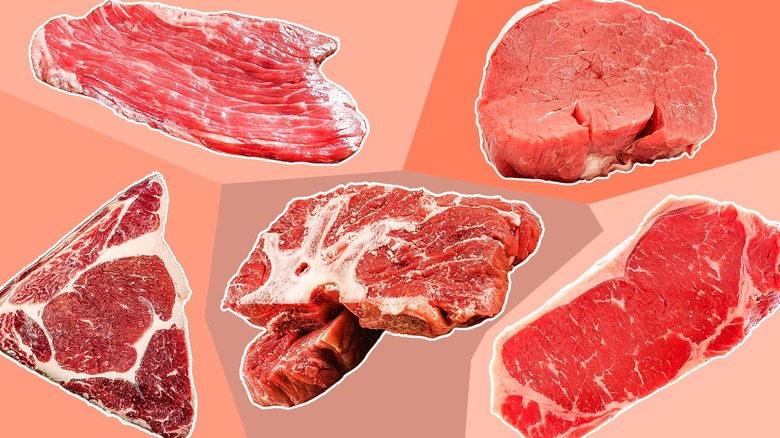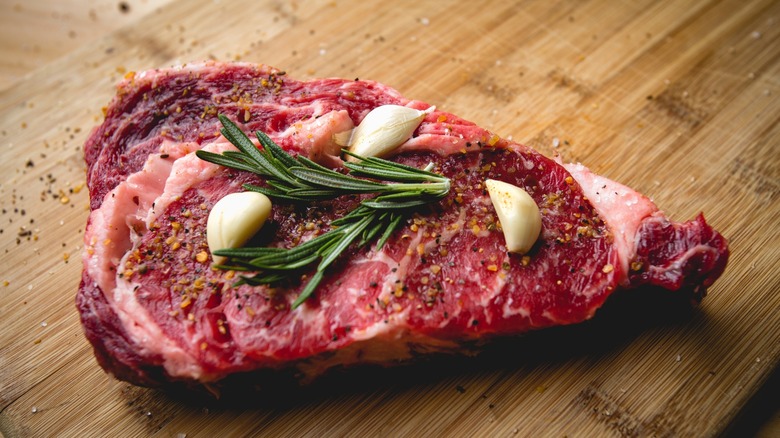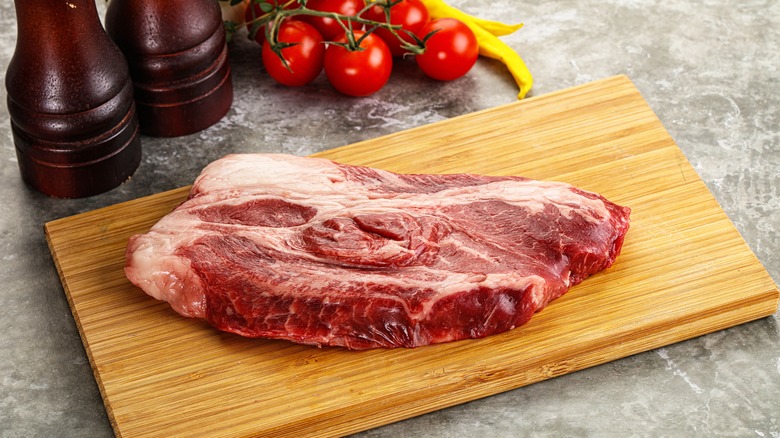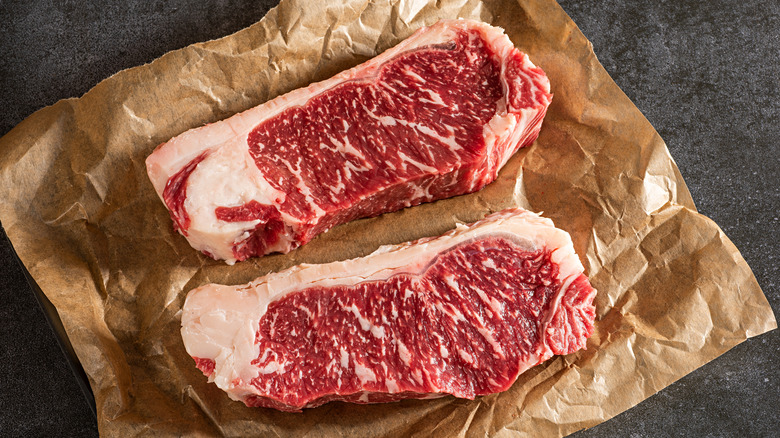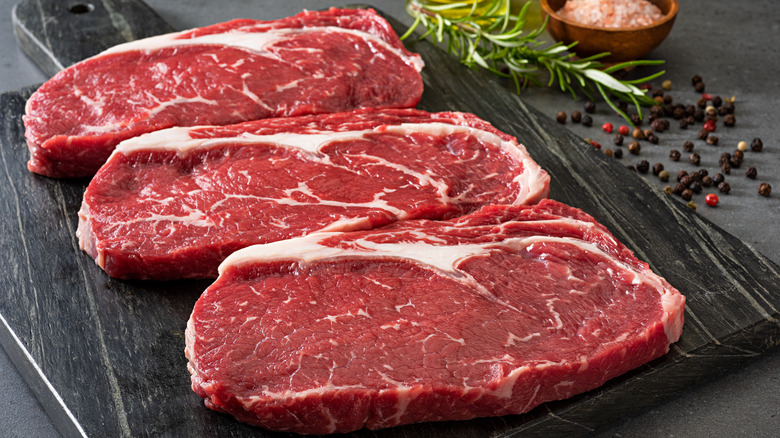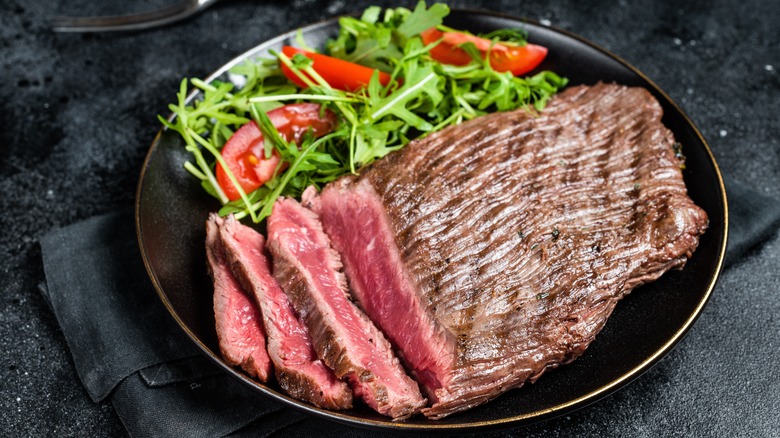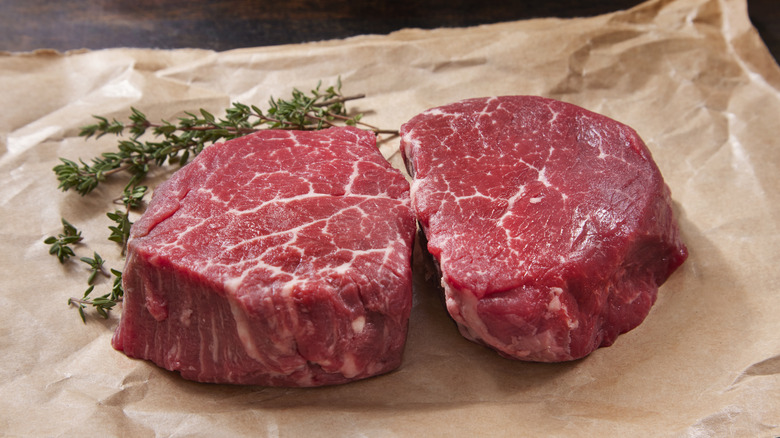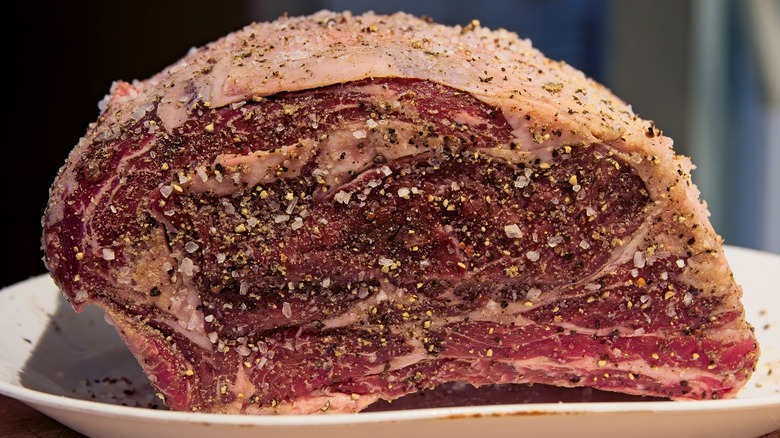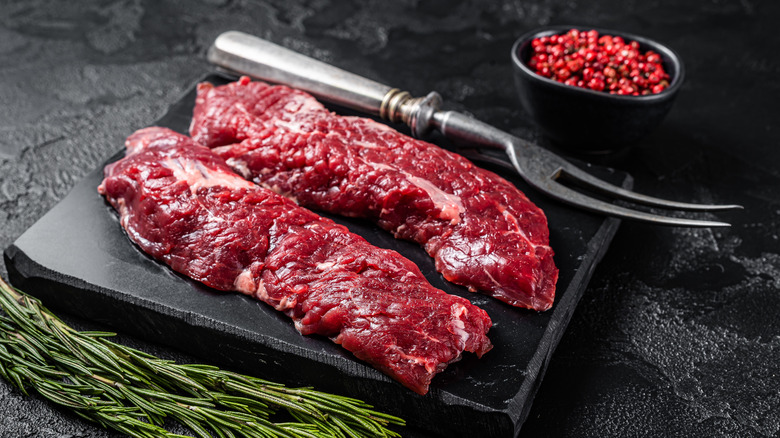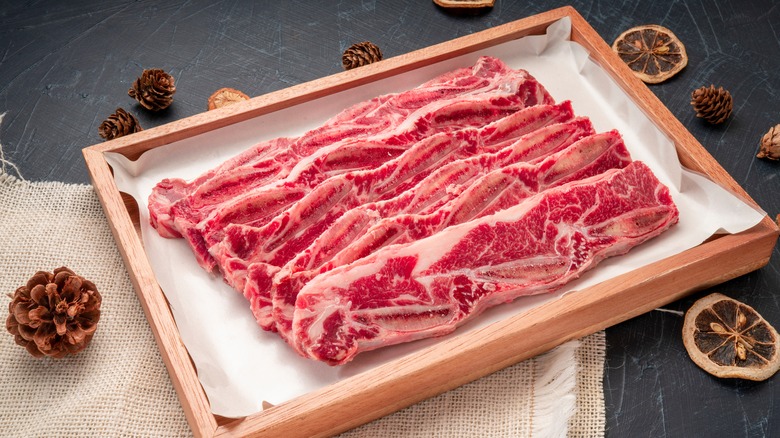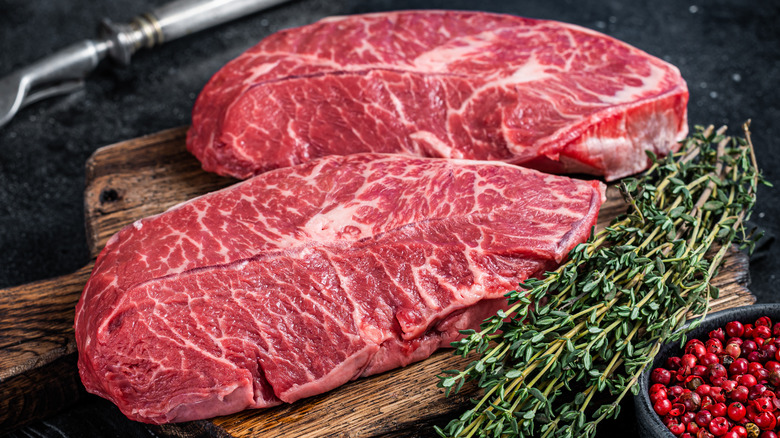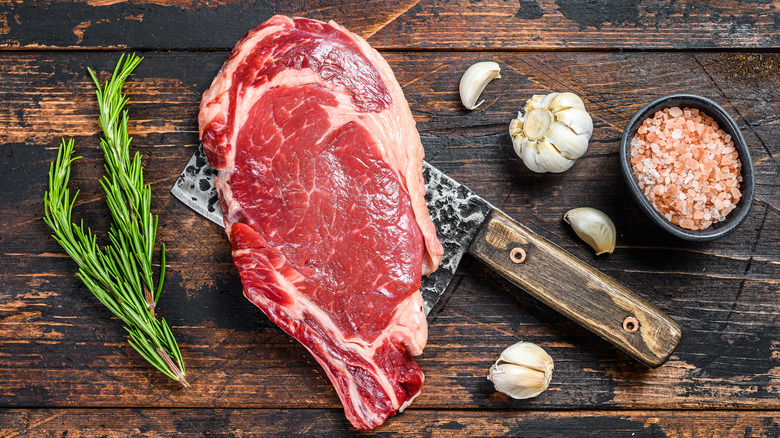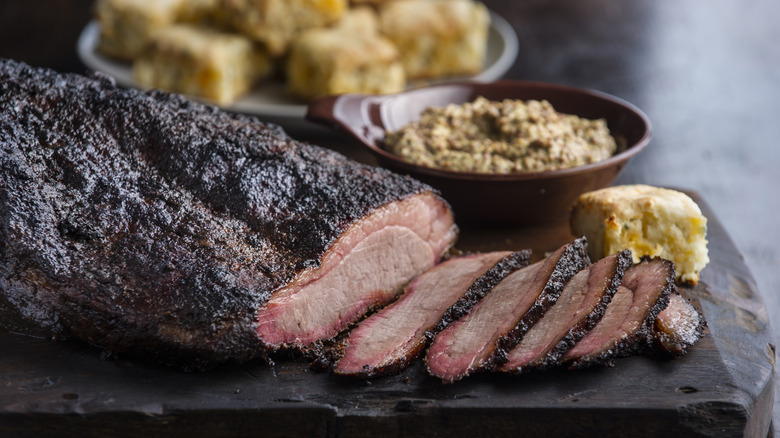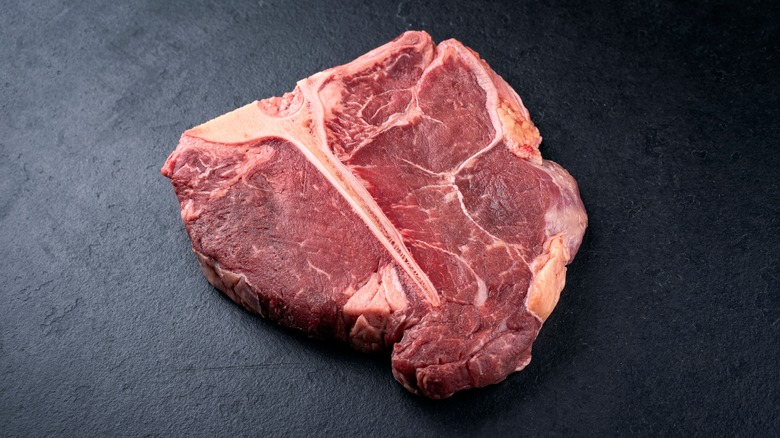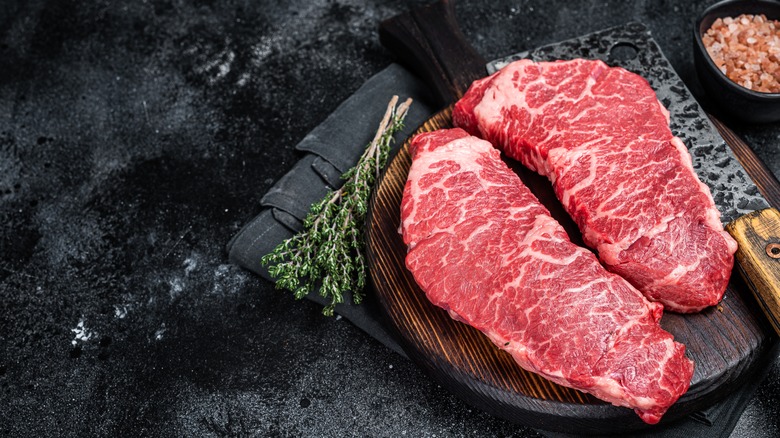14 Best Cuts Of Beef: The Only Grocery Store Guide You Need
Beef is the perfect protein when you want to cook a hearty, indulgent meal. With so many cuts available, though, how do you know which ones will taste best with the dish you're planning on making? Many home cooks choose their cuts of beef based simply on how big the cut is and how fresh it looks. While those criteria can come into play, it's also helpful to know the properties of different cuts of beef.
Beef cuts vary in texture and flavor. In general, muscles that a cow uses often will be tougher, while areas that get less use are more tender. This directly impacts how you should cook the meat. For example, the best cuts of steak for grilling are typically tender and will cook quickly in a pan or over fire. Tougher cuts need low-and-slow cooking to break down the connective tissue, so they're better for braising, smoking, and stewing.
Not sure which cut is right for you? We spoke to several chefs and meat experts to find out which cuts work best with various cooking methods. They offered advice on everything from the most indulgent cuts to flavorful cuts that won't break the bank, and even some underrated steak cuts you need to try.
Ribeye
If you're planning on cooking steaks on the grill, many experts say ribeye is the perfect steak for grilling. As the name suggests, this cut comes from the rib area of the cow. It typically comes without the bone, although you can find bone-in ribeyes that are also called cowboy steaks (more about those later). The muscles in the rib area of the cow don't get worked out as much as other muscles, so the meat is often tender and contains a good amount of intramuscular fat (a.k.a., marbling).
Chef Britt Rescigno, spokesperson for Pre Brands and winner of multiple Food Network culinary competitions, told us that the fat content is what makes ribeye so great for gilling. She said, "It's got amazing marbling that really allows the steak to pick up that beautiful smoky flavor that we love coming off the grill. Also, because of its intramuscular fat, it gets a super sexy crust on the outside of the steak." The fat also gives the ribeye its rich, buttery flavor and contributes to the juiciness of the steak.
Chuck steak
One cut of beef that doesn't work so well on the grill is chuck steak. This cut comes from the chuck primal, which is the shoulder part of the cow. Chuck steaks are cut from a larger cut of meat called the chuck roast. Because cows use their shoulders for support and walking, the muscles get a good workout. This makes the meat rather tough. Chuck steak also contains a lot of connective tissue, which can become extremely chewy if not cooked properly.
An effective way to cook chuck steak is to braise it or stew it. Chef Pete Geoghegan of Cargill Protein North America told Chowhound, "Moist heat cooking is a great way to break down the connective tissue, which will become gelatinous and give you great mouthfeel and add body and flavor to the stewing or braising liquid." Slow roasting or smoking can also break down the connective tissue, but it typically takes much longer than stewing or braising. Geoghegan said, "You can usually achieve tender beef in three hours or less in a conventional stew or braise."
New York strip
Packed with intense beefy flavor, the New York strip (also called a strip loin, Omaha strip, or Kansas City strip) is one of the most popular steak cuts. It comes from the short loin, which is located under the cow's backbone and home to some of the most succulent cuts of steak. As Jason Kennedy, in-house meat expert at Verde Farms, explained, "High-quality cuts from this area tend to have good marbling (intramuscular fat), which adds both flavor and tenderness. Loin cuts come from muscles that aren't heavily used by the animal, making them naturally more tender."
The New York strip is a great choice for a classic steak dinner because you can simply season it with salt and pepper or your favorite rub, then grill it, pan-sear it, or broil it. It can also be used in a wide variety of dishes like tacos, sandwiches, and salads. It's a great substitute for ribeye because it comes from the same muscle of the cow, but is often cheaper. The main difference between New York strip and ribeye steaks is the fat content. Strip steak has less marbling than ribeye, so you want to make sure you don't overcook it.
Sirloin
Sirloin is another common steak cut that has legions of fans. It comes from the sirloin primal cut of the cow, which is behind the short loin closer to the cow's hind legs. This makes it slightly leaner than loin cuts like the New York strip. However, it can still be juicy and flavorful with just a slight chew. Britt Rescigno said, "Sirloin is my absolute favorite. I love the rich beefy flavor, and if you cook it right, it's ridiculously tender." Even better, sirloin steak is often less expensive than strip steak or ribeye steak.
One thing to be aware of is that the sirloin is subdivided into the top sirloin and bottom sirloin. Top sirloin steak is more tender than bottom sirloin steak because it comes from a part of the sirloin that is closer to the loin and farther from the legs. It's also incredibly versatile, as you can grill, braise, or roast it. Jason Kennedy said, "It's perfect for a variety of dishes, from being sliced thin for quick tacos or stir-fries to being flattened, rolled, and stuffed for more elaborate meals like beef olives, roulade, or braciole."
Flank steak
Looking for a versatile cut of beef that works well on its own or in stir-fries and braised dishes? Flank steak may be just what you need. The flank is a primal cut that is located on the cow's belly under the loin. It's easily recognizable from the grain that runs along the meat. You may also see it labeled as jiffy steak. Flank steak is often cheaper than other cuts like the ribeye or sirloin, which makes it a great budget option.
Because flank steak is lean and full of beefy flavor, it's a great choice for dishes with strong-tasting sauces and spices like stir-fries and tacos. You can simply slice it and give it a quick cook in a hot pan or wok. Grilling is also an option, but you need to be careful not to overdo it because it can become chewy if it's overcooked. The key to grilling a flank steak just right is to marinate it before cooking to tenderize the meat. Pete Geoghegan told Chowhound, "You can put the whole flank in a marinade for six to eight hours, grill it whole, and slice (against the grain) thin for a special meal."
Filet mignon
Soft, buttery, and relatively lean, the filet mignon is one of the most sought-after cuts of steak. It comes from the tip of the tenderloin, which is a muscle that runs along the back of the cow near the spine. This small, tender cut only makes up a tiny part of the cow, which is just one of the reasons the filet mignon is so prized. It doesn't have much intramuscular fat, which makes it less marbled than other cuts like the ribeye. However, it still manages to be juicy and flavorful if cooked right.
"Filet mignon is the ultimate lean cut! It's my go-to because it's incredibly versatile and pairs perfectly with vegetables and sauces," president and co-founder of Melinda's Foods David Figueroa remarked. "It may be lean, but it's still tender and delicious!" It's the perfect steak for grilling because the high heat helps seal the juices in and the smokiness of the grill can enhance the slightly sweet flavor of the meat. Many chefs recommend cooking it to medium-rare so that it maintains its melt-in-your-mouth texture.
Prime rib
Prime rib is the ultimate cut of beef for roasting thanks to its beautiful marbling and rich, meaty flavor. Also called a standing rib roast, the cut comes from the primal rib area of the cow, which is just behind the shoulder. This is the same area that the ribeye comes from. In fact, the difference between prime rib and ribeye is simply that ribeye is sliced into steaks, while the prime rib is left as a larger cut. You can get prime rib with or without the bone.
The most common way to cook prime rib is to season it, sear it in a pan to get a nice crust on the exterior, then slow-roast it in the oven to medium-rare. You don't want to cook it too far past medium-rare because the fat may melt away and leave the prime rib tough and dry. With large pieces of meat like prime rib, you also want to let it rest before cutting into it so that the juices have time to redistribute throughout the meat. A good rule of thumb is to let it rest for about 30 minutes after coming out of the oven.
Hanger steak
You might not see hanger steak on too many steakhouse menus, but many chefs say this underrated cut of beef is a true gem. Chef Thomas Wenrich of Tyson Foods said, "A personal favorite of mine is the hanger steak. Historically referred to as the 'butcher's steak,' the hanger is an incredibly flavorful cut with my desired level of tenderness and cooks great over high heat for an easy weeknight dinner." The V-shaped cut is found "hanging" below the diaphragm of the cow between the loin and ribs. The texture is very tender with great marbling that gives it intense flavor and plenty of juiciness.
Although hanger steak is naturally very tender, you want to make sure you don't overcook it and dry it out. Author and chef Adonis Icalina of Carnivore Style said, "The trick is to marinate it well and cook it quickly over high heat to keep it juicy." Hanger steak works well on the grill, but can also be pan-fried to give it that direct heat source. The bold flavor of the steak pairs well with zesty spices and marinades, so don't be afraid to add some cumin, chili powder, or chimichurri sauce.
Short ribs
Tired of cooking the same old sirloin and strip steaks time after time? If you're looking to switch up your beef repertoire, you may want to consider beef short ribs. Short ribs typically come from the chuck area of the cow. Because they don't have enough meat on them to make steaks, they're sold as shorter cuts of the ribs, hence the name. Short ribs are often richly marbled, but they also have a great deal of connective tissue. This makes them ideal for braising or cooking low and slow.
Beef short ribs are often sold with the bone in and cut either parallel to the bone, across the bone, or sliced thin so they can be cooked quickly like Korean short ribs. Back ribs are another flavorful option. Don't be afraid to try different styles. As chef Shane Graybeal of Fielding's said, "Keep looking in the meat section like it's a rare vinyl shop and you'll soon start finding your own "secret" chops that you can't wait to share with everyone! I'm hesitant to share this but I love finding beef back ribs and slow cooking them for hours!"
Flat iron steak
Flat iron steak is another lesser-known piece of beef that many chefs say is seriously underrated. Thomas Wenrich told Chowhound, "Flat iron cuts are full of deep, rich beef flavor, are incredibly tender, and can be a value cut in comparison to more common steakhouse cuts." This nicely marbled cut is taken from the top blade roast and has similar qualities to ribeye, but is typically less expensive. It's a great alternative if you're looking for something affordable and ultra-tasty.
If cooked right, a flat iron steak can be juicy and full of flavor. The decent amount of marbling makes it great for grilling or pan-searing. You don't need to do much more to it than season it with salt and pepper, although a marinade can help tenderize the meat and add extra flavor. Ideally, you want to give it a quick sear and then cook it for a few minutes on each side depending on what temperature you want the meat to be. You can serve it as is or slice it and use it in tacos, on a salad, or in a sandwich.
Cowboy steak
Looking for a substantial cut of beef that never fails to wow red-meat lovers? The cowboy steak is essentially a ribeye, but what sets it apart from a regular ribeye is it still has the bone attached. You may see cowboy steak labeled as bone-in ribeye. If the bone is left long and untrimmed, it's called a tomahawk steak. Cowboy steaks are typically thick and hefty, weighing anywhere from 18 to 32 ounces. The meat is nicely marbled and the bone adds extra flavor and helps keep the juices in.
Because of the sheer size of the cowboy steak, it makes sense to cook it on the grill. You can use the common method of searing the meat on high heat first to get a nice crust, then move it over to lower heat to continue cooking it to your desired temperature. Alternatively, you can use the steakhouse secret of reverse searing. This involves cooking the steak with low heat first, then blasting it with high heat at the end to give it a crispy exterior.
Brisket
If you love barbecue-style beef, brisket should be on your radar. This primal cut comes from the chest area of the cow just below the shoulder. As you can imagine, this area gets a good workout because the cow uses those muscles to walk and support its body weight. Therefore, the meat contains a large amount of connective tissue. The brisket is cut into two pieces: the flat and the point. The flat is also called the "first cut" and it's leaner than the fatty point cut or "deckle."
Regardless of whether you buy the flat or point side of the brisket, you want to cook it low and slow to break down the connective tissue. Many people love smoking brisket because the smoke adds loads of flavor to the already rich meat. You can also braise your brisket in the oven or cook it in a slow cooker. Just be sure to sear it first to get a nice crust and lock in the juices. If cooked properly, you should be able to slice the brisket into beautifully tender pieces or shred it for pulled beef sandwiches or tacos.
T-bone & porterhouse
It's easy to see why T-bone and porterhouse steaks are favorites among steak aficionados. Both cuts come from the short loin of the cow and feature two steaks separated by a T-shaped bone. The smaller side features a buttery tenderloin filet, while the longer side is a bold-flavored New York strip steak. The only difference between a T-bone and a porterhouse is the size. The U.S. Department of Agriculture states that a porterhouse must be at least 1.25 inches thick on the tenderloin side, while a T-bone can be thinner.
Dagan Lynn, executive chef at Beef. It's What's for Dinner, told Chowhound, "These steaks are ideal for grilling due to their bone, which helps to keep the meat moist while it's cooking." You can start by seasoning the steak with salt and pepper or a mix of your favorite spices, then place it on the hot side of the grill to get a good sear. After it has a nice crust, move the steak over to lower heat and cook to your preferred temperature. Keep in mind that a porterhouse will need more time because of the size of the filet. As with any steak, let it rest after cooking to let the juices settle.
Denver steak
"If you're looking for something different and innovative to switch up your grilling menu, reach for a Denver steak," advised Dagan Lynn. This interesting cut is found in the chuck primal, which is typically known for its tougher cuts. However, the Denver steak comes from an area just under the shoulder blade that isn't used as much as the other muscles in the chuck area. Therefore, it's much more tender and has a decent amount of marbling. It's also typically less expensive than other more well-known cuts.
This tender cut benefits from hot and fast cooking to seal the juices in. Provided you don't overcook it, Denver steak can be incredibly buttery and juicy. The only downside is it can be difficult to find. Lynn said, "If you can't find a Denver steak at your local grocery store or butcher shop, try a bavette steak. A boneless cut with a hearty texture, bavette means "bib" in French and is a phrase referring to thin meats." Like Denver steak, bavette steak (a.k.a., flap steak) also has a decent amount of marbling and a nice beefy flavor.
